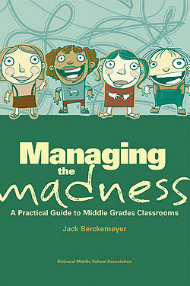Managing the Madness: A Practical Guide to Middle Grades Classrooms
Managing the Madness: A Practical Guide to Middle Grades Classrooms
By Jack C. Berckemeyer
(AMLE, 2009 – Learn more)

Every now and then, I find a book written by a teacher, for teachers, that is full of such wonderful wisdom and advice that I wonder how I ever managed to teach a class without using the strategies recommended.
Jack C. Berckemeyer has written one of those books.
Managing the Madness truly is a practical guide to middle grades classrooms that I would recommend to everyone. While it is focused on middle schools, the strategies contained within easily transfer to working with students of any age. As I read, I found myself highlighting sections, taking pictures and posting them online, and thinking, “Oh my goodness! I am going to use this idea tomorrow!”
What’s inside

From classroom management to group work to hallways to detentions to homework, he guides the reader through common situations and offers advice on how to help students develop the skills they need to be successful and, in the process, helps the teachers develop the patience, concern, and empathy needed to reach these students.
While it is great to read that this book is well worth the read, I have always believed in the old adage that the proof is in the pudding. Here are just some of Jack Berckemeyer’s suggestions for working with middle grades students.
On classroom management:
“Classroom management is about trial and error; it comes through practice, patience, teamwork, flexibility, quality mentoring, willingness to seek help when needed, and a huge dose of humor… There is no one solution or strategy for every classroom management problem that will occur. Try new ideas, take time to listen to your students, trust your instincts, and most important—have some fun along the way.”
On keeping students engaged:
“Dry erase boards can be a teacher’s best friend. Place one under every students desk. When you ask a question, students can write their answers on the dry erase board; if they do not know the answer, they can draw a question mark. When they are done, ask them to use both hands to hold the boards up in the air as high as they can reach. This forces to them to stretch and sit up straight. In addition to engaging academically. They are physically active in a positive way.”
On working in groups:
“…You need to realize that when young adolescents are in a group, they will socialize. It is part of who they are; they crave interaction with their peers. Their need to laugh, debate, and argue in groups helps build social skills and social norms—a critical part of their development.”
On identifying with students:

On managing work:
“At the beginning of class, give students only half of the worksheet; later give them the other half. This strategy counters the tendency of students to look at the time in a class period and the number of questions and feel. ‘I will never finish this time.’ For some students that list of twenty questions is overwhelming, and they shut down before they even start… [Another strategy is to] start class by saying, ‘We have a million things to do today.’ Write on the board a list of 10 items that students need to complete by the end of the day. And don’t worry about overwhelming them. Here is the important part: of the list of 10 items, only 5 are real.”
There is so much more in this book that I just don’t have room to share! Whether your middle grade students are still at an elementary school or getting ready to enter high school, the strategies within this book really do work! Don’t be afraid to try something new, and don’t be afraid to make mistakes. Just make sure you laugh with your class when you do! Your students will love you for it.
Alex T. Valencic is a fourth grade teacher in Urbana, Illinois. He has taught professionally for five years. When not teaching, Mr. Valencic can be found reading, riding his bicycle, and spending time with his family. While he used to have a full head of thick, curly hair, he shaved it all off in April after this school community logged over 1,000,000 minutes of reading! You can learn more about his adventures in teaching fourth grade by visiting his blog at http://teachingfourth.wordpress.com or following him on Twitter @alextvalencic.




































